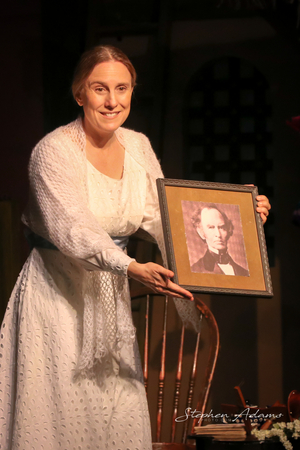Review: THE BELLE OF AMHERST at Rubicon Theatre Company

One-woman plays about historical figures are rare in the theater so when it was announced that Ojai resident Anna Kotula would be bringing William Luce's The Belle of Amherst, a profile of poet Emily Dickinson, to the Rubicon Theatre for a one-night benefit on August 31 for the theater's education and outreach programs, it became a must-see event. Kotula's prior engagement at the Ojai Art Center last December was a sell-out, attracting rave reviews. Her witty, poignant representation of the reclusive Dickinson (1830 - 1886) brings to life a vital, ebullient, yet private woman who engagingly shares stories and lines from her poems with the audience.
The Belle of Amherst won a Tony award for Julie Harris when she originally performed the show on Broadway in 1976. With her hair pulled back into a severe bun and wearing a dress of bridal white, Kotula speaks directly to the audience from her "Homestead," the house built in 1813 where Dickinson was born and where she lived for most of her life. Kotula transports herself back into time, when Dickinson was a vivacious fifteen-year-old, wistfully recalling her childhood, growing up in Amherst, Massachusetts (which she pronounced "Am-urst") with her parents, older brother Austin and younger sister Lavinia ("Vinnie"). "I wish we were always children," she muses, wistfully, recalling her upbringing when she was the only non-religious person in the family, making fun of the "grim, guilt-ridden sermons" she was forced to endure until she stopped going to church altogether while still a teenager. At 16, she attended Mount Holyoke Female Seminary, located ten miles from her home, but quit after one year and returned to her home, where she spent the rest of her life.
Although much has been made of Dickinson's life as a celebrated recluse, Kotula brings out Dickinson's warm-hearted memories of her solitary life, which she insists was "deliberate." She was close to her family, but none more than Austin's wife Sue, who became her best friend and confidante. Dickinson's father Edward, was an austere politician who almost never smiled. Kotula brandishes a framed photo of her father while relating stories about his severe nature. The paradox of The Belle of Amherst is how her father's death, from an attack of apoplexy in 1874, affected Dickinson. "Home is so far from home since my father died," she poignantly wrote after his death. A final tragedy occurred when her beloved nephew Gilbert, the 8-year-old son of her brother Austin, died tragically from typhoid.
Luce skillfully interweaves Dickinson's poetry into the narrative, so that if you were not familiar with her work, it would be difficult to discern when Dickinson is quoting from her poems from when she isn't. Kotula is especially radiant when she talks about the English language, reveling in words like "phosphorescent," a word "you can lift your hat to."
Act I ends as an excited Dickinson eagerly submits poems to Atlantic Monthly editor Thomas Wentworth Higginson and then giddily awaits Higginson's arrival at the Homestead to discuss them with her. After eight years of peppering Higginson with letters, Higginson dismissed her work by calling it "uncontrolled" and "spasmodic," sending Dickinson into a stunned depression from which she never escaped. "How dreary to be somebody," she said, soothing her hurt with her own words. The disappointments in Dickinson's life are balanced with her rhapsodic memories of mundane, everyday pleasures, such as sharing her recipe for "black cake," a kind of spice cake infused with molasses, raisins, and currants. (In a reception after the show, patrons were served miniature hunks of the confection along with glasses of champagne.)
Kenny Dahle's marvelous, carefully chosen set design showcases period furniture pieces and artifacts (supplied by set dresser Kitty Bartholomew), including framed photographs of members of Dickinson's actual family. The set itself consists of four rooms in Dickinson's home: a bedroom, a writing room, a sewing room, and a parlor with a sofa and the previously mentioned framed portraits.
Kotula, who has been known for her versatility and range as an actress, is also a skilled choreographer, having worked on many shows at the Ojai Art Center, including Carousel, Mame, and Dr. Dolittle. There, she has portrayed characters ranging from the broad comedy of Tanya in Mamma Mia and a bravura performance as Harpo Marx in Animal Crackers (both shows she also choreographed), to more serious studies such as Engaging Shaw (as George Bernard Shaw' wife) and a witch in Macbeth. Her magnificent work in The Belle of Amherst shows a deep understanding of all sides of Dickinson's complex personality, without reaching for pathos or sympathy. Despite her disappointment in having only seven of her poems published during her lifetime, Dickinson insisted that she lived her life the way she wanted to. In forecasting the end of her life, she spoke of an encounter with death personified in her poem, "Because I Could Not Stop For Death."
Because I could not stop for death
He kindly stopped for me;
The carriage held for just ourselves
And immortality
Anna Kotula's portrayal of Dickinson can be summed up by a word Dickinson herself would no doubt have loved: incandescent. Now there's a word you can lift your hat to.
Anna Kotula will be reprising her performance as Emily Dickinson in The Belle of Amherst in an encore run at Namba in Ventura, September 20-22. For dates and showtimes, see the VC On Stage Calendar.
Add Your Comment
Videos
